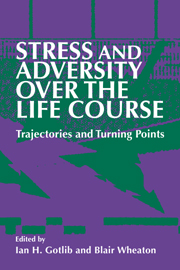Book contents
- Frontmatter
- Contents
- List of contributors
- 1 Trajectories and turning points over the life course: concepts and themes
- I Trajectories: long-term effects of adverse experience
- 2 Childhood adversity and adult psychopathology
- 3 The impact of twenty childhood and adult traumatic stressors on the risk of psychiatric disorder
- 4 Intergenerational sanction sequences and trajectories of street-crime amplification
- 5 School-leavers' self-esteem and unemployment: turning point or a station on a trajectory?
- 6 Intergenerational consequences of social stressors: effects of occupational and family conditions on young mothers and their children
- 7 Women's roles and resilience: trajectories of advantage or turning points?
- II Turning points: changes in life trajectories
- III New methods for the study of the life course
- Index
4 - Intergenerational sanction sequences and trajectories of street-crime amplification
from I - Trajectories: long-term effects of adverse experience
Published online by Cambridge University Press: 23 October 2009
- Frontmatter
- Contents
- List of contributors
- 1 Trajectories and turning points over the life course: concepts and themes
- I Trajectories: long-term effects of adverse experience
- 2 Childhood adversity and adult psychopathology
- 3 The impact of twenty childhood and adult traumatic stressors on the risk of psychiatric disorder
- 4 Intergenerational sanction sequences and trajectories of street-crime amplification
- 5 School-leavers' self-esteem and unemployment: turning point or a station on a trajectory?
- 6 Intergenerational consequences of social stressors: effects of occupational and family conditions on young mothers and their children
- 7 Women's roles and resilience: trajectories of advantage or turning points?
- II Turning points: changes in life trajectories
- III New methods for the study of the life course
- Index
Summary
Crime sometimes runs in families, and the re-appearance of crime among the sons of convicted fathers is especially well documented (e.g., Burt 1925). Yet there is little certainty about how and why this recurrence occurs. In this chapter we conceive of the arrests of sons whose fathers have been arrested as forming turning points in life histories that often increase involvement in crime. In this sense, sons’ arrests become galvanizing events that, as part of intergenerational sanction sequences, culminate in turning points and amplify crime trajectories.
Of course, our conceptualization is not the first attempt to account for the reappearance of crime across generations, and it is important to locate our effort in relation to earlier approaches to this issue. The original positivist criminologists saw the recurrence of crime across generations as evidence of a genetic link (e.g., Lombroso 1918). In contrast, early Marxist criminologists interpreted the re-appearance of crime as a result of economic necessity (e.g., Bonger 1916). Of the two hypotheses, the genetic one has proven more popular with lay and policy audiences (e.g., Wilson & Herrnstein 1985).
Research on the heritability of crime focuses on several populations, including intact biological families and twins, particularly those separated at birth. However, as noted by Walters and White (1989), many of these studies are compromised by sampling bias, inadequate control groups, differential mortality, and specification errors.
- Type
- Chapter
- Information
- Stress and Adversity over the Life CourseTrajectories and Turning Points, pp. 73 - 90Publisher: Cambridge University PressPrint publication year: 1997
- 4
- Cited by



